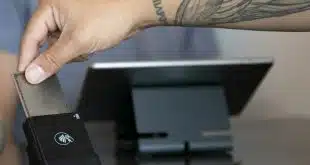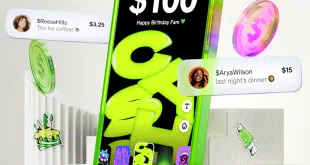General-purpose mobile wallets have yet to convince most merchants and consumers that they have real value. Can that change, and if so, when?
The hype over mobile wallets hasn’t ceased ever since Google Checkout launched way back in 2006, and it’s only become louder since Apple Inc. unveiled Apple Pay in September 2014. Apart from early-adopter enthusiasts, however, most merchants and consumers don’t seem to be getting the message.
The major selling point of the Big 3 ‘Pays’—Apple Pay, Google Pay, which is Alphabet Inc.’s successor to Google Checkout, and Samsung Pay from South Korea-based consumer-electronics giant Samsung—is fast contactless transactions using your smart phone. But contactless transactions from mobile wallets and so-called dual-interface plastic debit and credit cards combined account for 1% at most of U.S. point-of-sale purchases, payments executives say.
Despite this, another big Korean phone maker, LG, is expected to join the U.S. mobile-wallet fray at any time with its LG Pay service, already live in LG’s home country.
So why haven’t more American merchants and consumers jumped onto the mobile-payments train? And will things change in the near future?
Several major factors are holding the Pays back in the U.S. market, according to close market observers. They include a lack of contactless payments acceptance, the greater appeal of proprietary wallets to big merchants, and, despite plenty of hype, a general lack of awareness among consumers about the wallets.
“Things are kind of stagnant at the moment,” says Jordan McKee, the Boston-based principal analyst for payments at 451 Research.
Recent Converts
None of this is to say the wallets can’t turn things around. On the acceptance side, McDonald’s, Subway, Walgreens and many other national merchants accept the wallets, and new acceptance locations are being announced steadily.
Recent converts include the Pennsylvania Lottery, whose ticket machines will accept mobile wallets, and Metro, the public-transportation system in Washington, D.C. and its suburbs. Metro in April disclosed plans to accept mobile wallets in subway stations and on buses.
The infrastructure for potential wallet acceptance is growing, thanks in large part to the coming of EMV chip cards to the U.S. (“Contactless II,” April). Nearly all new EMV POS terminals come with near-field communication technology that enables acceptance of contactless transactions.
NFC also is now common in the leading smart phones, and it’s the core technology behind Apple Pay and Google Pay. Samsung Pay uses NFC too, though the service also uses a specialized technology that enables conventional magnetic-stripe POS terminals to accept it.
On the other side of the payments fence, a fair number of consumers now seem willing to dip their toes in the wallet waters. 451 Research reports that just over a third of new owners of Apple’s iPhone link a card to Apple Pay.
Similarly, 14% of owners of new smart phones running Alphabet’s Android operating system link a card to Google Pay. San Carlos, Calif.-based Crone Consulting LLC estimates Google Pay has 15 million active users.
“I think adoption is increasing steadily,” says Lawrence Berlin, a senior vice president at Chicago-based First Analysis Securities Corp. who follows the payments industry.
‘It’s Going To Take a Long Time’
The wallets have a long way to go, however. Millions of merchants still haven’t bothered to turn on the NFC functionality in their new EMV terminals. Only 18% of U.S. merchant locations accept contactless payments, according to Mastercard Inc.
“It’s going to take a long time for contactless acceptance to be ubiquitous,” Jamie Topolski, director for output solutions at Fiserv Inc., a Brookfield, Wis.-based banking processor and payments provider, said in late March at a Secure Technology Alliance conference in Orlando, Fla.
Many merchants, especially smaller ones, see little need for NFC, partly because they and their customers have just gotten used to contact chip transactions in which an EMV card is inserted into the terminal.
Meanwhile, only about 5% of U.S. general-purpose EMV payment cards are of the dual-interface variety that supports both contact chip payments as well as contactless NFC transactions. Card manufacturers and payment processors say demand for dual-interface cards is building, but it has yet to reach critical mass.
Further, some of the nation’s biggest merchants favor proprietary mobile-payment systems. At Starbucks, which rolled out a proprietary system in 2011, mobile payments account for 30% of U.S. tender. Dunkin’ Donuts, Kohl’s, CVS, Potbelly, and some others also have branded mobile wallets or payment services, just about all of which eschew NFC in favor of familiar barcodes.
No. 1 retailer Walmart Inc. includes its Walmart Pay service, which uses quick-response codes, in its general mobile app. Rival discounter Target Corp. is coming out with its own variation on that theme that links mobile payments to its proprietary Redcard debit and credit cards.
Last November, Walmart senior vice president Dan Eckert boasted to the Bloomberg news service that Walmart Pay could surpass Apple Pay in usage at stores where they’re accepted. Walmart does not accept the Pays.
Walmart, Target, and CVS were members of the Merchant Customer Exchange (MCX), a group of about 40 retailers that formed in 2012 and developed CurrentC, a mobile-payments system separate from the general-purpose card networks. The idea was to not only reduce card-acceptance costs, but also to create attractive loyalty programs.
Some MCX members, however, including Walmart and CVS, began developing their own mobile-pay systems apart from CurrentC. Ultimately, retailers gave up on a joint effort and last year sold CurrentC’s technology to JPMorgan Chase & Co., which used it to develop its own Chase Pay app.
“I definitely see those merchants that were in MCX going down that path to develop their own wallets,” says McKee. “I definitely think we’ll see more of that.”
‘More To Offer’
A key advantage of proprietary wallets is their ability to draw on the retailer’s customer data and easily link discounts and rewards redemptions with payments (“Mobilizing the Store Card,” March 2017).
“Part of the reason Walmart Pay is so successful is they have more to offer than Apple Pay, Samsung Pay, and Google Pay,” says payments researcher Richard K. Crone of Crone Consulting. “It has all these features that streamline the purchasing process.”
Plus, the merchants put plenty of marketing support behind their branded wallets to build customer awareness and usage. By comparison, promotions for the Pays seem paltry.
The services do run promotions in digital and general media channels—Google, for example, until May 14 is offering Google Pay users who refer friends for the service up to $100 in credits good on the Google Play app market after a new user makes his or her first purchase.
Apple’s marketing tactics include email promotions to Apple Pay users that highlight merchants in specific categories and niches. But the Pays have yet to match the proprietary wallets’ marketing resources.
“There’s nowhere near the marketing they need,” says Berlin of First Analysis.
Alphabet recently rebranded Android Pay as Google Pay. Earlier names for the service were Google Wallet and Google Checkout (“Field Guide to Alternative Payments, this issue). It’s no wonder if consumers are confused.
Apple, Alphabet, and Samsung did not respond to Digital Transactions’ requests for comment.
‘The Big Hurdle’
The Pays sometimes get assists from card issuers. A recent example comes from Minneapolis-based U.S. Bancorp, a major commercial card issuer and owner of the big merchant acquirer Elavon. In April, the holding company’s U.S. Bank enabled its Mastercard travel cards to be loaded into Apple Pay, Google Pay, and Samsung Pay. That move followed a similar one last year for the bank’s Visa travel cards.
“We’re really excited about mobile payments, mobile apps, as it relates to corporate and commercial cards,” says Peggy Yankovich, product and marketing manager for large-market bankcard. “We had client demand for it.”
Facilitating mobile wallets keeps U.S. Bank at the cutting edge of payment innovation, and enhances cardholder choices, according to Yankovich.
“We’re capturing transactions we would have had on plastic anyway, but it’s allowing customers and potential customers, corporates and their employees, to pay the way they want to pay,” Yankovich says, adding that the bank will be providing “a lot of education” about mobile wallets to its cardholders.
Next up, though it could take up to a year and a half, is linking U.S. Bank’s purchasing cards to the Pays. “In the corporate space it’s a little bit more complex,” she says.
The demand for cardholder payment choice may become the Pays’ best friend, particularly as NFC spreads throughout the U.S. merchant base and the services continue to add enrollees who could turn into frequent users.
“I don’t think you as a merchant should be limiting customer choice … to pay for something,” says McKee of 451 Research.
The Pays, however, can’t just sit by waiting for that to happen; they’ll especially need to find a way to persuade small merchants to come on board.
“That’s the big hurdle for the space, to guide these small merchants that don’t see any impetus to invest,” McKee says.
‘Here To Stay’
Another avenue to greater adoption is integration with person-to-person payment services such as Apple Pay Cash. The Apple Pay offshoot runs on Apple’s Messages app and competes with PayPal Holdings Inc.’s Venmo and Zelle from the big-bank-owned Early Warning Services LLC.
“They can ride the coattails of people sending money to virally increase adoption,” Crone says. “The master of this script is really PayPal and Venmo.”
Still another tactic for the Pays is working with retailers to embed their credentials into mobile apps that facilitate order-ahead-and-pay transactions, a fast-growing payments segment. Crone says fast-casual chain Panera Bread Co. gets about 30% of sales through order-ahead, and he predicts order-ahead-and-pay could capture 60% of sales in the entire quick-service restaurant sector in coming years. That could be good news for general-purpose wallets.
“The Pays are here to stay,” says Crone. “They’re not going to go away.”
Recent Consumer Mobile-Wallet Adoption Trends
34% of new iPhone owners link a card to Apple Pay during the device onboarding process.
14% of new Android smart-phone owners link a card to Google Pay (formerly Android Pay) during the device onboarding process.
8% of Samsung smart-phone owners have tried Samsung Pay in the past 90 days.
8% of Android smart-phone owners have tried Google Pay in the past 90 days.
19% of iPhone owners have tried Apple Pay in the past 90 days.




